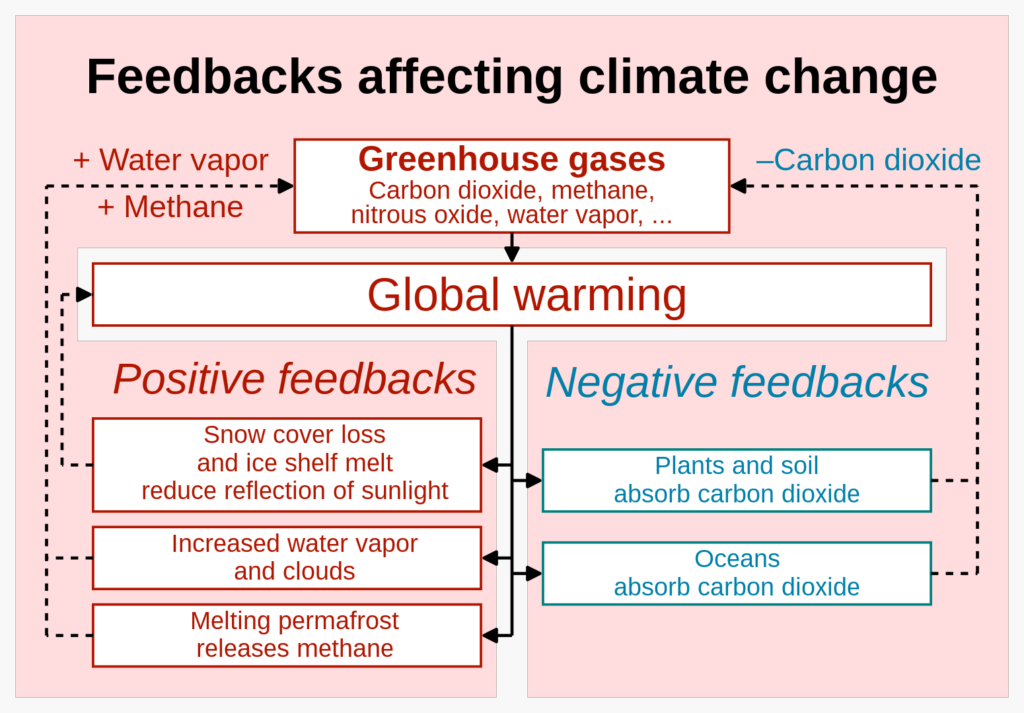A feedback loop is created when reactions affect themselves: A causes B, which in turn influences A (and C), and so on – it feeds back into itself. The continual movement of the loop frequently results in higher-order effects.
Feedback loops can be positive or negative:
- Positive: a reinforcing effect – A produces more of B which in turn produces more of A. You may know them as virtuous and vicious cycles.
- Negative: a regulating effect – a change in A is brought back in line by an opposite change in B to maintain balance in the system. Every action creates an equal and opposite reaction.
Positive feedback, by itself, leads to instability via exponential growth or chaotic behavior. Negative feedback, on the other hand, promotes stability and settling to equilibrium. Positive feedback loops are effective for creating change, but generally result in negative consequences if not moderated by negative feedback loops.
You’ll find feedback loops in all complex systems, with negative feedback loops being necessary in a homeostatic system. Feedback loops in such a system maintain a “static” environment unless an outside force changes the loop.
Complex systems and feedback loops are all around us:
- Human body
- Temperature regulation: our body signals our brain when it gets too hot. The brain relays information and the blood flow to our skin increases, making us sweat. This lowers our body temperature. If instead, we get too cold, our blood flow gets reduced and we start shivering, which raises our body temperature.
- Blushing: a positive “shame loop” occurs in people who blush easily. When they realize they are blushing, they become even more embarrassed which leads to more blushing.
- Immune responses and recovery from infections and injuries: when injured or sick, diverse cell types interact with each other to produce positive feedback loops. Cells influence each other to cooperate and restore damaged or infected tissue.
- An example of failure in a system due to outside forces is cancer. It causes elements in the above feedback loop to fail, disrupting the (natural) tissue function and immune system.
- Biology: the way nature regulates animal populations. Species prey on one and become food for another…which become food for another. This creates a balance in nature. Human intervention can be seen as a disruptor of the (natural) feedback loops in this system.
- Engineering: a thermostat regulating room temperature uses a negative feedback loop. As the temperature rises, the thermostat switches off the furnace. When the temperature falls below a predetermined temperature, the thermostat reactivates the furnace.
- Economics and business
- Product recommendations influence the choices of new consumers. Negative ones lead to fewer sales, while positive ones lead to more sales. Social proof and herd behaviour often lead to this rich-get-richer effect.
- Scale: as companies get bigger – increased sales, profits and customers – they benefit from cost advantages and stronger purchasing power, are able to diversify and offer more products and services, and continuously improve its competitive advantage.
- A negative feedback loop that regulates scale advantages is bureaucracy. As the company increases in size, so do its bureaucracy and processes, stifling its growth.
- Finance and sociology
- A self-fulfilling prophecy: if enough people believe something to be true, their behaviour can make it true. These actions in turn further fuel their belief. The output of the reaction becomes its own catalyst (auto-catalysis). A classic example of this kind of ‘runaway feedback loop’ is a bank run.
- Hyperinflation: a very high and typically accelerating inflation.
- Network effect: as more people join a network, it becomes more valuable, increasing its reach and causing the network to expand more quickly. The limiting factor in this case is population size: at some point you run out of people. A Ponzi scheme is a good example.
Often a complex system involves multiple feedback loops working with and against each other.

So, remember this: things are connected – changing one variable in a system affects other variables in that system (and other systems).
Understanding feedback loops helps you identify intended and unintended consequences, and do higher-order thinking. Deepening your understanding is straight-forward: study history. It tends to repeat itself.
How to use Feedback Loops
In sports, skill acquisition or studies, timely feedback from a coach, teacher or mentor speeds up your progress. It helps you correct your mistakes (negative feedback loop) and focus on what works (positive feedback loop).
The more you can have such feedback loops working for you, the more you can focus on deliberate practice that improve your performance, one step at a time.
In language learning, every aspect can be more quickly improved with feedback loops.
- Reading: translating, summarizing or answering questions about a text help you identify where your comprehension is lacking.
- Listening: subtitles – in the original or in your native language – help you realize if you’re hearing the language correctly and let you look up words you don’t know.
- Writing: bidirectional translation allows you to compare your written output with the original text.
- Speaking: talking with a tutor on a topic you’ve prepared to give you feedback on pronunciation, intonation, proper use of vocabulary and filling in gaps in knowledge.
In teaching or mentoring, you need to give and receive feedback to understand if your message is coming across properly. Too many are focused on talking; not enough are focused on listening. To deliver corrective feedback successfully be nonevaluative, supportive, timely, and specific. Combine it with incentives and reinforcement to improve the odds of success.
Pingback: Incentives: The Hidden Forces That Shape Behavior